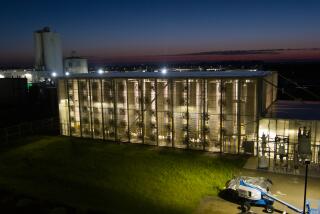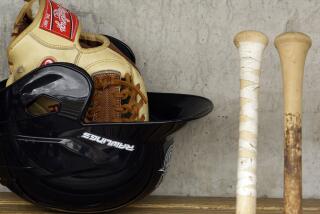Solar Race Teams Managed to Weather the Elements
SAN GABRIEL VALLEY — Tropical Storm Arlene--no friend to solar cars--had thundered in from the Gulf of Mexico the night before the big race.
The first day of racing was ominously rainy, the roads slick. Thirty-four collegiate teams pined for the national solar car title in the weeklong, 1,100-mile race from Arlington Stadium in Texas to the Minnesota Zoo in Minneapolis.
Cal State L.A.’s car, Solar Eagle II, was flying along Texas Highway 133 leading the pack, its 1,600 tiny solar cells straining to catch the sun. Misfortune struck just outside the Denton city limits, 60 miles into the race: trouble with the throttle that controls electric current.
Solar Eagle II glided to a stop along a flat, grassy field, its motor shot. Waiting for a new motor cost four precious hours in elapsed time.
The Cal State L.A. team sank to 29th place but quickly made up the lost time and gunned to a third-place finish in Sunrayce ‘93, which started June 20 and ended June 26. But it was not enough to beat archrival Cal Poly Pomona, which took second place with its entry named Intrepid.
The University of Michigan won first place by 1 1/2 hours. The Michigan team won $56,000 in cash and prizes; Cal Poly Pomona, $5,000; and Cal State L.A., $4,000.
Sunrayce ’93 is a biennial competition for science, math and engineering students in North America. The event, sponsored primarily by the U.S. Department of Energy and General Motors, requires students to design and build a race car powered only by solar energy.
Solar car batteries are charged by the sun instead of connection to an electrical current. Solar cells on the car’s surface collect sunlight, which is converted to electrical energy that is stored in batteries similar to ones in ordinary cars.
The race cars, which look like bubble-topped wedges on three wheels, operate much like the all-electric cars that are expected to be on the mass market in the mid-1990s.
The race drew hundreds of onlookers at major stops, including autograph seekers and “CBS This Morning” anchor Paula Zahn, who interviewed Cal State L.A. driver Ricardo Espinosa, a 24-year-old mechanical engineering senior.
Despite the throttle setback, Cal State L.A. senior Carlos Moran never lost faith in Solar Eagle II, even as 28 competing cars sailed by. While the 22-member team worked feverishly on repairs, Moran helped hold a tarp over the car to keep the rain off the electrical system and counted the passing competitors--26 . . . 27 . . . 28 . . . .
“I kept my spirits high,” said Moran, 27, a mechanical engineering major. “I said, ‘We can do it, we can do it.’ ”
More than a week after the incident, team members say they still don’t know what went wrong. The car’s motor controller inexplicably failed at a time of high hopes--Cal State L.A. had finished No. 1 in a qualifying round.
As the Cal State L.A. team pushed to make up lost time, Cal Poly Pomona’s 20-member team was locked in a neck-and-neck race with the University of Michigan throughout the week.
Day three was particularly fierce. Michigan started the day 56 seconds in front of No. 2 Cal Poly Pomona. Seconds count. Teams can lose if they misjudge the sun or misread the slope of the hills.
The race turned into a friendly game of chicken between the two teams along a two-lane highway through Oklahoma. Michigan pulled ahead, then Cal Poly Pomona passed. Three times the lead changed hands.
“There’s nothing you can do,” said Carl Rathmann, Cal Poly Pomona’s associate dean of the college of engineering. “When someone passes you, he’s going maybe a tenth of a mile faster than you are.”
By day’s end, Michigan had the lead, temporarily.
But judges assessed a 20-minute penalty against Michigan because one of its support vehicles had run a red light. That put Cal Poly Pomona ahead, temporarily.
At the finish line, Michigan prevailed. Michigan’s average speed over the entire race was 27.2 m.p.h. Cal Poly Pomona’s car averaged 26.3-m.p.h.
Seconds count.
Although he was not at the race, Rathmann kept in close telephone contact with the team, which has not returned to California.
He insisted that winning was not important. “It’s not even a competition,” Rathmann said. “It’s more in the nature of cooperatively advancing technology.”
But, he added, did you know that Michigan brought along two meteorologists to help the solar team’s strategists work with the weather? Two! And Cal Poly Pomona had none!
More to Read
Inside the business of entertainment
The Wide Shot brings you news, analysis and insights on everything from streaming wars to production — and what it all means for the future.
You may occasionally receive promotional content from the Los Angeles Times.










